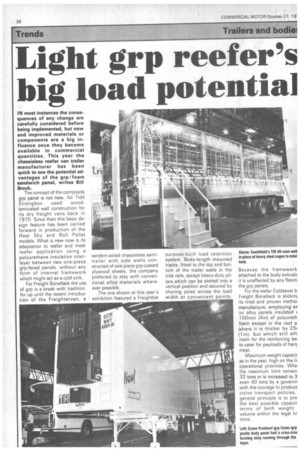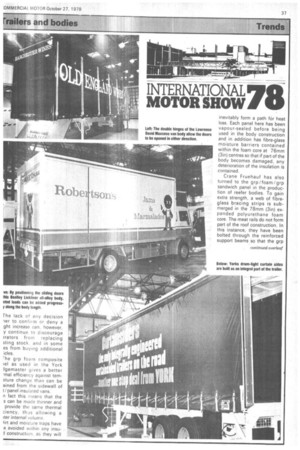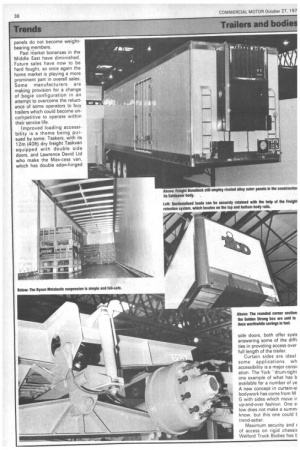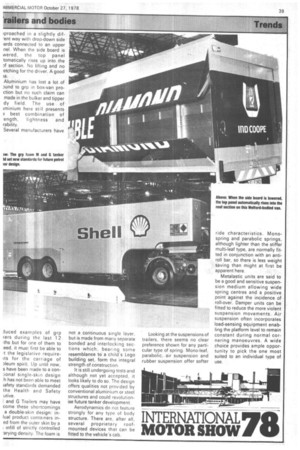Light grp reefer's big load potential I N most instances the
Page 38

Page 39

Page 40

Page 41

If you've noticed an error in this article please click here to report it so we can fix it.
consequences of any change are carefully considered before being implemented, but new and improved materials or components are a big influence once they become available in commercial quantities. This year the chassisless reefer van trailer manufacturer has been quick to see the potential advantages of the grp/foam sandwich panel, writes Bill Brock.
The concept of the composite grp panel is not new, for Tidd Strongbox used woodlaminated wall construction for its dry freight vans back in 1970. Since then this basic design feature has been carried forward in production of the Heat Shy and Roll Pallet models. What is new now is its adaptation to reefer and meat reefer application using a polyurethane insulation interlayer between two one-piece grp-faced panels, without any form of internal framework which might act as a cold sink.
For Freight Bonallack the use of grp is a break with tradition, for up until the recent introduction of the Freightervan, a tandem-axled chassisless semitrailer with side walls constructed of one-piece grp-coated plywood sheets, the company preferred to stay with conventional alloy materials whereever possible.
The one shown at this year's exhibition featured a Freightlok purpose-built load retention system. Body-length mounted tracks, fitted to the top and bottom of the trailer walls in the side rails, accept heavy-duty pillars which can be slotted into a vertical position and secured by shoring poles across the load width at convenient points. Because the framework attached to the body extrusi( it is unaffected by any flexin the grp panels.
For the reefer Coldsaver b Freight Bonallack is stickini its tried and proven metho( manufacture, employing ex or alloy panels insulated 100mm (4in) of polyureth foam except in the roof a where it is thicker by 251 (1 in), but which still all( room for the reinforcing be to cater for payloads of ham meat.
Maximum weight capacit as in the past, high on the li operational priorities. VVhe the maximum limit remain 32 tons or is increased to 3 even 40 tons by a governr with the courage to producE cisive transport policies, general principle is to pro the best possible capacit terms of both weight volume within the legal lir tions. the lack of any decision ler to confirm or deny a ght increase can, however, y continue to discourage :rators from replacing sting stock, and in some es from buying additional ides.
The grp foam composite lel as used in the York lgemaster gives a better -mai efficiency against tem3ture change than can be ained from the sidewall of t/panel insulated vans.
n fact this means that the s can be made thinner and provide the same thermal ciency, thus allowing a iter internal volume.
iirt and moisture traps have e avoided within any insu1 construction, as they will inevitably form a path for heat loss. Each panel here has been vapour-sealed before being used in the body construction and in addition has fibre-glass moisture barriers contained within the foam core at 76mm (3in) centres so that if part of the body becomes damaged, any deterioration of the insulation is contained.
Crane Fruehauf has also turned to the grp/foam/grp sandwich panel in the production of reefer bodies. To gain extra strength, a web of fibreglass bracing strips is submerged in the 78mm (3in) expanded polyurethane foam core. The meat rails do not form part of the roof construction. In this instance, they have been bolted through the reinforced support beams so that the grp
continued overleaf panels do not become weightbearing members.
Past market bonanzas in the Middle East have diminished. Future sales have now to be hard fought, so once again the home market is playing a more prominent part in overall sales. Some manufacturers are making provision for a change of bogie configuration in an attempt to overcome the reluctance of some operators to buy trailers which could become uncompetitive to operate within their service life.
Improved loading accessibility is a theme being pursued by some. Taskers, with its 12m (40ft) dry freight Taskvan equipped with double side doors, and Lawrence David Ltd who make the Max-cess van, which has double edge-hinged
side doors, both offer syst€ answering some of the diffil ties in providing access over full length of the trailer.
Curtain sides are ideal some applications wh accessibility is a major consi■ ation. The York "drum-tight one example of what has b available for a number of ye A new concept in curtain-si bodywork has come from M G with sides which move ir up-and-over fashion. One s, low does not make a surnmi know, but this one could t trend-setter.
Maximum security and ( of access on rigid chassis Welford Truck Bodies has 1 duced examples of grp (ers during the last 1 2 iths but for one of them to :eed, it must first be able to :t the legislative requireas for the carriage of Dleum spirit. Up until now, S have been made to a contional singe-skin design :h has not been able to meet safety standards demanded the Health and Safety utive.
I and G Trailers may have come these shortcomings a double-skin design: inlual product containers in• ed from the outer skin by a infill of strictly controlled 'arying density. The foam is
not a continuous single layer, but is made from many separate bonded and interlocking sections which, bearing some resemblance to a child's Lego building set, form the integral strength of construction.
It is still undergoing tests and although not yet accepted, it looks likely to do so. The design offers qualities not provided by conventional aluminium or steel structures and could revolutionise future tanker development.
Aerodynamics do not feature strongly for any type of body structure. There are, after all, several proprietary roofmounted devices that can be fitted to the vehicle's cab. Looking at the suspensions of trailers, there seems no clear preference shown for any particular type of spring. Mono-leaf, parabolic,, air suspension and rubber suspension offer softer ride characteristics. Monospring and parabolic springs, although lighter than the stiffer multi-leaf type, are normally fitted in conjunction with an antiroll bar, so there is less weight saving than might at first be apparent here.
Metalastic units are said to be a good and sensitive suspension medium allowing wide spring centres and a positive point against the incidence of roll-over. Damper units can be fitted to reduce the more violent suspension movements. Air suspension often incorporates load-sensing equipment enabling the platform level to remain constant during normal cornering manoeuvres. A wide choice provides ample opportunity to pick the one most suited to an individual type of use.
































































































































































